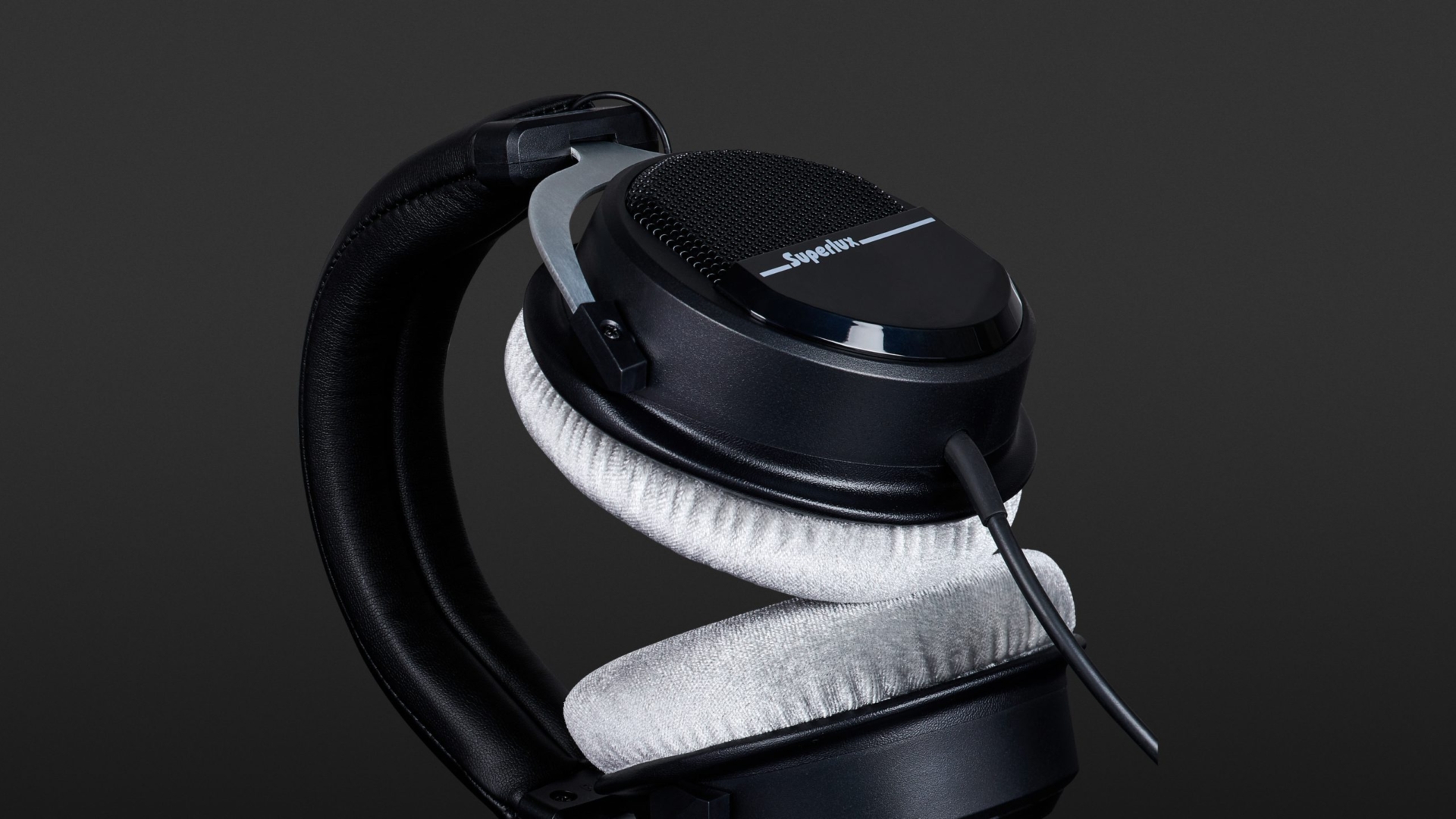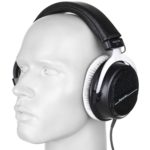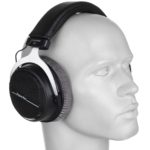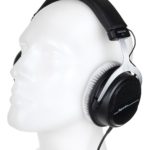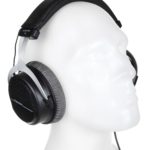With the Superlux HD330Pro, the Taiwanese company does almost everything right: Considering the sound you get, the price can be described as extremely reasonable, and their sound is in a class “bigger” than their price. However, points are deducted for the rather imperfect gap where the headband meets the driver cable. The fact that the cable is soldered doesn’t get a round of applause from me either, but it’s okay, considering the price range. However, this all fades into the background as soon as you indulge in the impressively clear and precise sound of these headphones, which can be enjoyed pleasantly for hours on end thanks to their semi-open design.
- very differentiated and lively mid and high frequencies
- wide frequency response
- two versions with different impedance for optimum dynamics
- pleasantly serious and professional appearance
- reasonable price
- large gap between headband and cable outlet
- cable firmly soldered
When Superlux introduces new headphones, you can be justified in getting excited, because no other company manages to conceal such great sound behind such a small price. And this is also true of the new Superlux HD330Pro semi-open studio over-ear headphones, which are available in 32-ohm and 150-ohm versions. The 32-ohm model being tested here impressed us with its surgical precision.

The headphones from the Taiwanese music equipment manufacturer Superlux (go to the overview) have regularly secured top positions on our price-performance leader board in recent years. And they have done so with remarkable continuity because, despite price tags that are regularly in the lower two-digit range, there have been, and still are, no really bad drop-offs in quality. The new HD330Pro semi-open studio headphones continue this trend in fine style.
The design of the Superlux HD330Pro
The HD330Pro are semi-open, circumaural headphones. This means that air is exchanged with the environment through the rear panel, which is perforated with holes. This has advantages because when worn for long periods, neither unpleasant heat build-up nor the famous “diving bell effect”, where you feel completely isolated from your surroundings, occur as quickly. However, a little more sound penetrates from the inside to the outside, which is a disadvantage of this design when used in recording situations in the studio – when recording vocals, for example – and it leads to “crosstalk” into the microphone. Another disadvantage of this design is not quite as much sound pressure is able to build up in the bass range as it would with in-ears or closed headphones. From my own many years of experience as a live and studio sound technician, I know that closed headphones become annoying on the ears much more quickly during longer sessions than semi-open ones.
Superlux HD330Pro: available in two versions
With hi-fi and studio scenarios in mind, the HD330Pro come in two versions – with 32 or 150 ohms impedance. The choice between the two versions is relatively simple to make: if you are using the headphones with low-power input devices – i.e. anything that runs on batteries or rechargeable batteries – you should go for the 32-ohm version. If, on the other hand, they are mainly going to be used with mains-powered players and correspondingly powerful amplification, you should choose the 150-ohm version.
Why? For example, if we assume an output voltage of one volt at the source (a simple AA battery has 1.5V), the 32-ohm version already delivers 31.25 mW of power, whereas the 150-ohm version only delivers 6.6 mW. So you would have to supply the 150-ohm version with four volts to get the same power. The theoretical advantage of a high impedance is an extended dynamic range since a larger voltage range is available. Personally, I have seldom heard a really significant sonic advantage. This was also the case in our test; in a direct comparison (with the corresponding feeder devices), I did not detect any significant difference between the 150- and 32-ohm versions. Only when the 150-ohm version was plugged into a mobile phone was it audibly noticeable that it was receiving too little current to be fully effective.
The other technical data also looks professional: 40-millimetre drivers with neodymium magnets are used, and these have a sensitivity of 93 dB and – according to the manufacturer – are capable of reproducing frequencies in a range between 10 Hz to 30 kHz.
The HD330Pro’s appearance and handling
Due to their design, the HD330Pro are somewhat bulky “cans”, weighing 315 grams, which makes them comfortable on the head of the listener as thanks to the thicky ear and skull pads, the weight is distributed very comfortably on the head. All three pads can be removed and replaced if necessary. In terms of overall appearance, particularly with the grey ear pads and the positions of the screw connections, the HD330 was somewhat reminiscent of the DT 990 Pro from Beyerdynamic. Whether this is intentional or whether this design was inevitable when building semi-open, circumaural headphones, I will pass over at this point. I would also like to mention another – rather unpleasant – design similarity: The connecting cable between the left and right earpieces is routed through the headband on both headphones and just “somehow” comes out from underneath; this is not only visually unattractive but also causes the padding to protrude somewhat. This is much better handled by the Beyerdynamic DT 1990 Pro because they have a recess in the plastic through which the cable is neatly routed to the outside. The 2.5 metre-long connection cable is firmly soldered and comes out of the left headphone. It ends in a stereo mini-jack plug that can be expanded to a standard jack with the included adapter.
How the Superlux HD330Pro sound
“Wow, they’re crispy,” is the first thought that pops into my head after I put the HD330Pro on for a listening test with Dawuna’s debut album “Glas Lit Dream” on the player. This album is an ideal tester for headphones with its quiet lo-fi frippery and many micro edits. And the Superlux HD330Pro delivered the music with surgical precision: on the sonically innovative “The Lighthouse”, these headphones reproduce even the smallest snippets of crackle and field recordings.
In the ultra-high range, this is so engaging that even my treble reference headphones – the DT 1990 Pro from Beyerdynamic – would be a little envious. With German rapper Sido’s distinctive sibilant Ss, as exhibited by “Liebst Du mich” from his album “Paul”, for example, this can sound almost exhausting. But, according to their own statement, this was the declared aim of the Superlux developers: To build headphones that convey a lot of body and emotionality, especially in the mids and highs, and they have certainly achieved this. The bass, on the other hand, was a little more discreet, almost taking a back seat to the impressive highs and mids. Fans of powerful bass-driven entertainment may find this too little thrusting, but fans of music that is performed more lightly will love the sound image.
Technical specifications
- Ear couplingOver-ear
- Typesemi-open
- Transducer principledynamic
- Frequency response (headphones)10 - 30.000 Hz
- Impedance29,6 ohms
- Sound pressure level (SPL)95,37 dB
- Pressure averaged from big and small head636 g
- Weight with cable318 g
- Weight without cable278 g
- Cable length245 cm
What's in the box
- 6.35mm stereo jack
- pouch
Special features
- available as 32 ohm version and 150 ohm version









